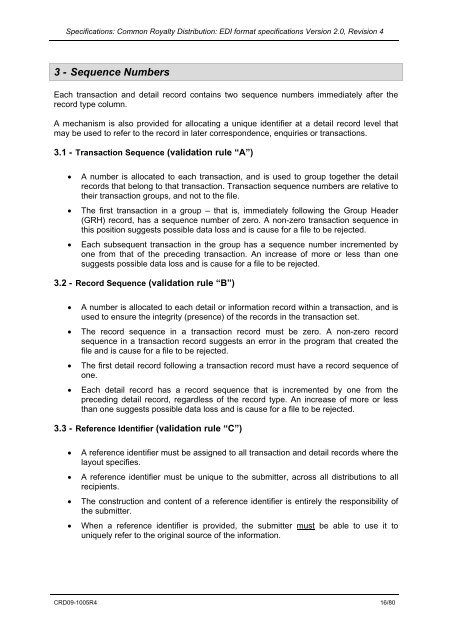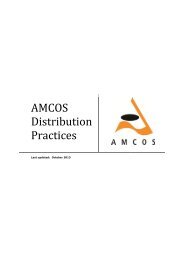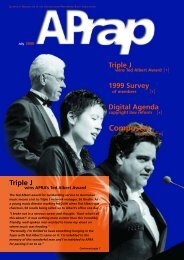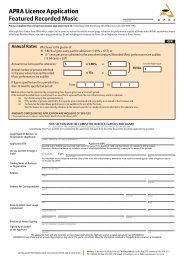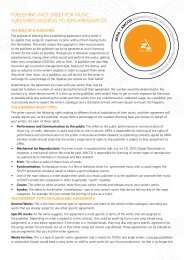EDI format specifications Version 2.0, Revision 4 - APRA
EDI format specifications Version 2.0, Revision 4 - APRA
EDI format specifications Version 2.0, Revision 4 - APRA
You also want an ePaper? Increase the reach of your titles
YUMPU automatically turns print PDFs into web optimized ePapers that Google loves.
Specifications: Common Royalty Distribution: <strong>EDI</strong> <strong>format</strong> <strong>specifications</strong> <strong>Version</strong> <strong>2.0</strong>, <strong>Revision</strong> 4<br />
3 - Sequence Numbers<br />
Each transaction and detail record contains two sequence numbers immediately after the<br />
record type column.<br />
A mechanism is also provided for allocating a unique identifier at a detail record level that<br />
may be used to refer to the record in later correspondence, enquiries or transactions.<br />
3.1 - Transaction Sequence (validation rule “A”)<br />
• A number is allocated to each transaction, and is used to group together the detail<br />
records that belong to that transaction. Transaction sequence numbers are relative to<br />
their transaction groups, and not to the file.<br />
• The first transaction in a group – that is, immediately following the Group Header<br />
(GRH) record, has a sequence number of zero. A non-zero transaction sequence in<br />
this position suggests possible data loss and is cause for a file to be rejected.<br />
• Each subsequent transaction in the group has a sequence number incremented by<br />
one from that of the preceding transaction. An increase of more or less than one<br />
suggests possible data loss and is cause for a file to be rejected.<br />
3.2 - Record Sequence (validation rule “B”)<br />
• A number is allocated to each detail or in<strong>format</strong>ion record within a transaction, and is<br />
used to ensure the integrity (presence) of the records in the transaction set.<br />
• The record sequence in a transaction record must be zero. A non-zero record<br />
sequence in a transaction record suggests an error in the program that created the<br />
file and is cause for a file to be rejected.<br />
• The first detail record following a transaction record must have a record sequence of<br />
one.<br />
• Each detail record has a record sequence that is incremented by one from the<br />
preceding detail record, regardless of the record type. An increase of more or less<br />
than one suggests possible data loss and is cause for a file to be rejected.<br />
3.3 - Reference Identifier (validation rule “C”)<br />
• A reference identifier must be assigned to all transaction and detail records where the<br />
layout specifies.<br />
• A reference identifier must be unique to the submitter, across all distributions to all<br />
recipients.<br />
• The construction and content of a reference identifier is entirely the responsibility of<br />
the submitter.<br />
• When a reference identifier is provided, the submitter must be able to use it to<br />
uniquely refer to the original source of the in<strong>format</strong>ion.<br />
CRD09-1005R4 16/80


